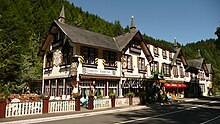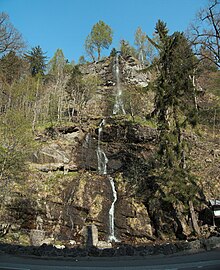Romkerhalle
Romkerhalle (often also called Romkerhall ) in the community-free area of Harz in the Lower Saxony district of Goslar ( Germany ) is a property consisting of a hotel and restaurant in the Oker valley of the Harz low mountain range . Also because of the Romkerhall waterfall , it is a popular excursion destination, which is marketed as the " Kingdom of Romkerhall - the smallest kingdom in the world!"
Geographical location
Romkerhalle is located in the Upper Harz in the Harz Nature Park about 5 km south of the Goslar district of Oker and about 1.5 km (as the crow flies ) northeast of the Okerstausees on the federal highway 498 running parallel to the Oker at about 335 m above sea level. NHN . About 200 m to the south is the Romkerhalle hydropower plant , which generates electricity from the water in the reservoir. The restaurant belongs to the city of Goslar and the power station to the community of Schulenberg in the Upper Harz, which is located south of it (Samtgemeinde Oberharz). Coming from the east, first the Große Romke and then the Kleine Romke flow into the Oker between the power station and the Romkerhalle .
history
In order to promote and facilitate traffic, the Okertal began to develop roads at the beginning of the 19th century. In 1817 the first driveway was built in the Okertal according to a plan by the chamber secretary of Eschwege - it ran under the back of the goats over the student cliff and box corner. The log removal was also now easier and the traders could easily reach the Upper Harz. This narrow and romantic path is still available and accessible on the eastern side of the valley in the lower slope. It descends to Romkerhalle, where a large, arched stone bridge used to cross the Oker.
Under the direction of the chief miner Ahrend, the construction of a new, “comfortable road” through the Okertal to the birch valleys was undertaken. It was built from 1856 to 1861 with great difficulty, which caused the blasting of the large rock masses that reached to the bank, for the sum of 28,945 thalers. In 1865 wood was rafted for the last time under the direction of the chief smelter and the weir built in 1542 below the church in Oker was demolished. After that, several wood grinders could be set up in the lower Okertal.
The rocks of the Romkerhall waterfall drew attention even before it was built. From 1861 onwards, the Forestry and Hunting Directorate in Braunschweig leased 40 square rods and a two-acre area from the forest location Käste No. 3, Revier Oker, to the innkeeper Lüer from Oker for the construction of a restoration building . Its inauguration by the owner and operator H. Lüer took place on May 1st, 1863.
To make the property easier to reach, the Harzburg bathing commissioner Hermann Dommes had a promenade path laid out from Harzburg over the Kästeklippen (Käste) to Romkerhalle in 1863 .
The first land register records have only existed since the Hulsch family took over the property (1890). In 1903 the Villa Helene was built as a boarding house and in 1928 a hall was added over the Oker. In the last days of the Second World War , the Oker bridges of today's B 498 at Waldhaus and immediately south of Romkerhalle were blown up , but this did not stop the US Army marching in. In addition, the property was badly damaged and the reconstruction lasted until 1948.
Since 1988 the changing operators of the restaurant there have been promoting the place with the Kingdom of Romkerhall . They justify this with the fact that the properties are not assigned to a municipality , but are located in the municipality-free area .
Romkerhall waterfall
geography
In Romkerhalle of Oker valley below the collapsed on the rocky eastern Huth Berg -Ausläufers Small Romke ( 441.7 m above sea level. NHN ) of about 64 m high Romkerhall waterfall as by far the highest art waterfall in the resin at the Romke cliff (Contemporary also Rohmkerklippe or marble cliff called) down. Part of the water from the Kleine Romke tributary to the Oker is led there via an approximately 350 m long ditch.
history
The current place name Romkerhalle (initially Rohmker-Halle ) has only been used since the opening of the restaurant and Logirhaus by H. Lüer in 1863. To make the newly opened property more romantic, the artificial waterfall was created in the same year. This was initially only put into operation in the afternoon and formed a veil cascade that was reminiscent of the Staubbach Falls in the Swiss Lauterbrunnen Valley in the Bernese Oberland and attracted thousands of visitors.
geology
The rocks of the Romkerhall waterfall essentially consist of limestone. In the Upper Devonian about 370 million years ago there was a sea here. It was divided into basins and thresholds. Limes were deposited on the thresholds that were closer to the water surface (carbonate threshold facies of the Upper Harz Upper Devonian). About 300 million years ago, the rock package was folded, sunk, altered by invading granites, later lifted again and then exposed by erosion. So it happens that today we find these old limestone exposed on the waterfall rock and the raven cliff to the west of it. In the Okertal lying in between there are Kulmton slates. The ascent to the waterfall rock takes place on a hillside path north of the rock. A few meters of dark slate horn rock of the Lower Carboniferous are exposed at the foot. The waterfall rock up to the viewing platform consists of Upper Devonian limestone, which is heavily disturbed tectonically. Due to the nearby oker granite, which was glowing at the time, about 290 million. Years, all adjacent rocks hardened and overprinted with contact metamorphosis.
tourism
Romkerhalle is the starting point and transit point for many hiking trails. A path leads down the river along the Oker, which is surrounded by steep rocks. The rocks are particularly used by climbers on weekends. There are numerous large boulders in the river, between which small islands have formed from alluvial material, including the engagement island, which can be reached via a wooden bridge and which is included as no.116 in the system of stamping points of the Harz hiking pin. From Romkerhalle steep paths lead up to the south located Ahrendsberger cliffs and to the north-east at Huth mountain located mousetrap and from there to the fort . The view of the settlement and the waterfall falls from the Ahrendsberg cliffs . A little to the west of Romkerhalle is the Rabowklippe , which gained a certain reputation in 2013 because of the risk of a rock fall.
literature
- Hans Joachim Franzke, Irene Joss: Granite rocks and Romkerhaller waterfall in Okertal , Clausthal University of Technology, on dgg.de, without year (PDF; 362.4 kB)
- Hans-Joachim Franzke, Rainer Müller: Excursion in a geological profile through the western and central Harz . In: Heinz-Gerd Röhling (Hrsg.): GeoHannover 2012 - GeoRohstoffe for the 21st Century . Excursion guide and publications of the German Society for Geosciences 248, Hanover, 2012
- The Okertal in the Harz Mountains with Hotel Romkerhalle. Official guide of the Association for the Elevation of Tourism in the Oker Valley, based in Romkerhalle, member of the Harzer Verkehrs-Verband, Association for the Elevation of Tourism in the Oker Valley , Hulsch, Romkerhalle near Oker (approx. 1932).
Web links
- Kingdom of Romkerhall ... the smallest kingdom in the world! (official homepage)
- Romkerhall and its waterfall cliffs - geology and development of a historical tourist site , on magazin.harzinfo.de
- Romkerhalle in: Historic restaurants in the Harz Mountains , on sites.google.com
- Granite rocks and Romkerhall waterfall in the Okertal , description of the property (with photos and map) at the State Office for Mining, Energy and Geology in Lower Saxony (PDF; 408.6 kB), on lbeg.de
Individual evidence
- ^ Kingdom of Romkerhall - the smallest kingdom in the world! , on koenigreich-romkerhall.eu (title on home page)
- ↑ Topographic map of Romkerhalle ( Memento of the original from February 22, 2014 in the Internet Archive ) Info: The archive link was automatically inserted and not yet checked. Please check the original and archive link according to the instructions and then remove this notice. , on natur-erleben.niedersachsen.de
- ↑ a b c K. B. Fischer: Chronicle of the Harzburg Office ... , 1912
- ↑ a b R. Wieries: History of the Harzburg Office after its forest, field and street names , 1937
- ↑ a b A. Saft: Oker. A Chronicle 1883–2007 ... , 2008
- ↑ Lower Saxony State Archives Wolfenbüttel 50 Neu 5, No. 4817
- ↑ H. Schucht: Chronicle and local history of the Hüttenort Oker , 1888
- ↑ The Kingdom of Romkerhall and its history. In: www.koenigreich-romkerhall.eu. Retrieved May 31, 2016 .
- ↑ a b Map services of the Federal Agency for Nature Conservation ( information )
- ↑ The Kingdom of Romkerhall and its history , on koenigreich-romkerhall.eu
- ↑ The former imperial free imperial city of Goslar am Harz , 1863, p. 153.
- ^ H. Schucht: Chronicle and local history of the Hüttenortes Oker , Harzburg, 1888, p. 150.
- ↑ F. Behme: Geological Harz Guide ... , 1922
- ↑ H.-J. Franzke & I. Joss: Granite rocks and Romkerhall waterfall in the Okertal ... , without a year
- ↑ H.-J. Franzke & R. Müller: Excursion in a geological profile through the western and central Harz , 2012
- ↑ Harzer Wanderadel: stamp point 116 / Verlobungsinsel in der Oker , on harzer-wandernadel.de
Coordinates: 51 ° 51 ′ 34 ″ N , 10 ° 28 ′ 17 ″ E






